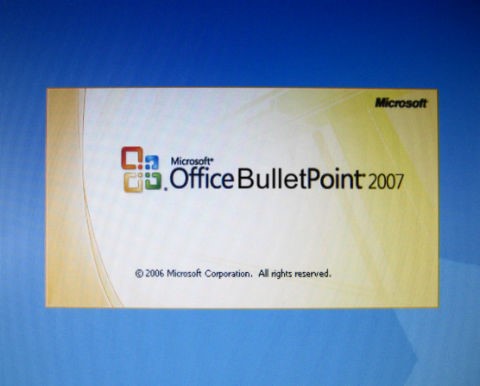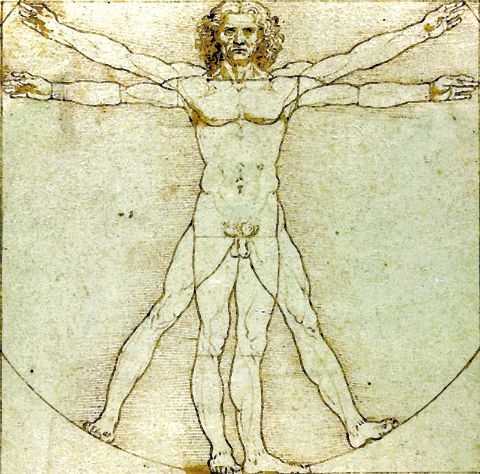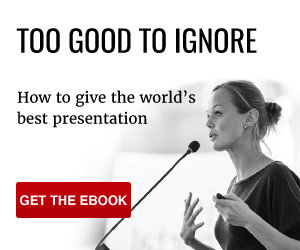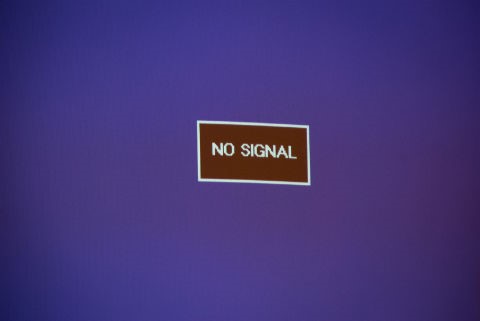What would you do if you were confronted with this screen?
Um and ah over your laptop while you wait for IT support, or just get on with your presentation?
If your presentation hinges on your slides then there is something wrong. The same thing applies if you’re relying on a printed pitch book in a client meeting.
As soon as you stop engaging with your audience, stop being human and stop thinking on your feet and become a mere narrator, you’re in trouble.
‘Let’s just talk about your business’
In one of his first briefing meetings as CEO of IBM, Lou Gerstner switched off the presenter’s projector and said, after a minute of awkward silence, ‘Let’s just talk about your business.’
Gerstner was onto something.
When faced with giving a presentation, people tend to become dry, rigid, jargon-spouting automatons. They forget what a presentation is: a forum for communication. And, as with all professional communication, it needs to be an effective exchange of information – a conversation between speaker and audience. In other words, at some level, all good presentations are a dialogue not a monologue.
Slides? Where we’re going, we don’t need slides

If you want to present like a human and get your point across, think about your slides last. Better yet, forget about them. Do you really need them?
If you start with the slides, your PowerPoint (or Keynote or Prezi) becomes the star of the show and the content you want to share with your audience gets lost in the wings.
Start with the story. Stories trigger emotional responses, they’re memorable and they inspire action.
Some of the most successful presentations employ a detective fiction narrative, says TED curator Chris Anderson. The audience is presented with a problem and the speaker describes their search for a solution. There’s an ‘aha!’ moment, and the audience’s perspective shifts in a meaningful way.
‘I discovered very early on that broadcasting is the control of the suspense,’ said the veteran broadcaster Alistair Cooke. ‘No matter what you’re talking about – gardening, economics, murder – you’re telling a story. Every sentence should lead to the next sentence. If you say a dull sentence people have a right to switch off.’ It’s the same with presentations.
Instead of opening up PowerPoint, just scribble down a skeleton of what you want to say – main argument, key points, and relevant data, examples and authorities. From these cocktail napkin notes you can then build up a word document, putting together your research, collecting thoughts, data and images, and playing with the structure and flow until you’ve got a coherent presentation.
Once you’re happy with the content, distil it all down to a central idea, and draw out the three points you want your audience to remember about your presentation.
Only when you’ve gone through this process should you think about what sort of slides, if any, you want to support your presentation.
Get naked
 Of course, with few or no slides, the attention is going to be on you.
Of course, with few or no slides, the attention is going to be on you.
So you need to get used to presenting naked, says presentation guru Garr Reynolds.
(Not literally, though. HR wouldn’t approve. Important tip.)
He means that you should strip away everything superfluous from your presentation. No gimmicks, no stock photography, no animations – no clutter.
So how do you present naked?
- Less is more. The emptier, and fewer, your slides, the better. Stick to powerful images, short quotations and clear tables, graphs and infographics. With fewer slides you also have the freedom to skip ahead or jump back if you’re late or the audience asks questions.
- Make eye contact. Don’t turn your back on your audience or read from the slides. As you give your presentation try to make eye contact with a few friendly-looking people around the room. It helps if you’ve had the time to memorise your presentation, but, if not, you can quickly refer to bullet points on note cards.
- Don’t hide. Use a small remote and get out from behind the podium. You don’t have to wander around like Gordon Brown, unless that comes to you naturally. Just stand confidently, keep your lower body still and use hand gestures for emphasis.
- Silence is your friend. Don’t worry about pausing or stopping to take a sip of water. Silence commands more authority than a barrage of ‘um’s, ‘er’s and ‘sorry’s. And if your PowerPoint freezes just carry on.
- Be human. Try to tell a story. If it’s a very technical or data-heavy presentation, pull out the most pertinent data to tell your story and then share the rest in a handout or online. No corporate jargon or sales speak. That means no hype, ‘paradigm shifts’, ‘solutions’ or ‘actioning’.
- Get excited, not nervous. Instead of trying to calm down, channel your nerves into excitement. Research at Harvard Business School found that those who told themselves ‘I am excited’ before a stressful situation outperformed those who repeated to themselves ‘I am calm’.
Think TED
 When in doubt, think TED.
When in doubt, think TED.
Yes, these overly-earnest, blue-sky talks have been lampooned. But they work.
Since TED went online in 2006, the videos have been viewed more than one billion times.
Why?
The speakers have presence and passion, they ask questions, they’re well-rehearsed and tell stories. Above all, they don’t rely on slides to make their points for them. They do that themselves.
(Image hat tips: ‘No signal’ by Peter Kofler, MS Office BulletPoint by s_p_a_c_e_m_a_n, Vitruvian man by Leonardo da Vinci, TED by Pierre Omidyar.)

